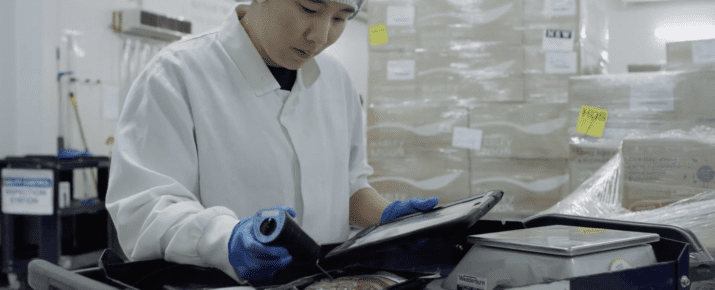Why Paper Checklists Are Stunting Your Growth
Checklist Best Practices | By | 13 Apr 2016 | 5 minute read

You’re no longer using paper for project management, invoicing or to communicate with all the stakeholders involved in your business. Why would you continue to use paper checklists for safety or quality assurance? By eliminating the cumbersome processes around paper audits and reporting, you can maximize growth within your organization and streamline old processes. With quicker audit updates and visibility into the entire organization’s safety analytics, digitizing your audits will ensure your organization is ready to scale quickly and efficiently. Here are the main considerations you need to keep in mind, whether you’re migrating from paper to digital, or you’re just looking to refresh your current digital audits.
Create templated audits for document control
Digitizing your checklists allows you to effortlessly control the multiple templates that auditors are using. Rather than sending out updated paper checklists that may take days or weeks to reach their intended auditors, you can update those templates immediately and automatically from your own master template. You also no longer have to worry about trying to track down outdated paper checklists to ensure your new initiatives are successful. This also allows for much simpler and quicker testing and iteration. Each checklist requires a certain amount of field testing, and it’s much simpler to do this in a digital format than to roll out paper checklists, collect feedback via a survey, and then update the checklist to redistribute. The digitization allows you to get audits in the hands of frontline workers quickly, then collect objective data on the audits (how long are they taking to complete? Are the completion rates high?). Once you collect that information, you can iterate on the audit and push out updates to frontline workers immediately.
This (nearly) instant gratifications means you can scale the auditing process incredibly quickly. As an administrator, adding new locations or auditors is simply a matter of a few clicks and you’re up and running.
This document control provides another benefit in that you can maintain these templates easily and ensure there are no variations or versions that you need to normalize for data collection later. You can even duplicate the master template you create and make small adaptations that apply to specific quarterly reviews or different job sites. This duplicating with minor tweaks provides more more standardized reporting than creating ad hoc reports and will also enforce a systemic change within your organization. If each template is similar and pulled from the “master template”, the repetition of filling out that template over and over will become engrained in the company practices.
Monitor auditing stats to track compliance
Anyone focused on quality assurance and safety compliance have an arsenal of checklists for frequent use. All of these audits are pivotal to maintaining daily safety and quality assurance standards, but can be easily overlooked by both the auditor and manager, simply because of the vast number of audits conducted. A manager could receive hundreds or perhaps thousands of paper audits per month. If these audits are conducted, it’s difficult to get the results back to a manager in a timely fashion. It may be weeks before a manager discovers that audits have not been conducted at regular intervals. Furthermore, when those paper audits are returned they may be illegible thanks to coffee spills, grease stains, or other normal wear and tear. With a digital checklist you’ll immediately see when audits are completed and be able to identify where and when audits aren’t completed as frequently as they need to be.
You can also easily measure compliance to see how long each audit is taking or whether there are certain questions are being frequently skipped. Assess the auditing process itself to ensure you’re empowering the auditors to adhere to safety and quality standards.
Automate communication to get everyone on the same page
SafetyCulture iAuditor allows instant communication between the person conducting the audit and the manager. Once an audit has been completed, the report is immediately shared with a manager or a group, depending on the preferences you set. Get real-time reporting and communication on critical issues.
Using SafetyCulture’s API you can also customize notifications to alert you when an audit score is below a certain threshold, or when a particular question has been answered as “Not Safe”, for example. With SafetyCulture’s integration to Zapier, you can set up a workflow flexible enough for any notification request. A restaurant may be experiencing issues with bathroom cleanliness, for example. They can set up an automated workflow so when a bathroom audit’s score is below 80%, the managers on duty will receive a SMS notification so they know to devote attention to those bathrooms. This effectively allows managers to be in multiple places at once and frees up the time they would otherwise devote to checking those bathrooms or following up on paper reports. By customizing notification settings you can ensure that only the critical issues are brought to your attention, and tune out the unnecessary noise if audits are being reported as expected.
This automation around communication is not specific to the auditor and manager relationship, you can also use it to communicate safety and quality assurance progress (or even project progress in general) with automated audit sharing. NA Group, a road construction company out of Australia, uses iAuditor’s photos to report on progress after each shift. This was a communication previously took days to complete, but can now be completed before the morning shift even starts with iAuditor. As you’re getting ready for a meeting to report on safety or quality assurance initiatives, you can also very easily compile reports and share those with the leadership team, rather than passing paper reports through multiple hands.
Get automated reports and avoid manual data entry
Another major drawback of paper checklists is that if you need to save any record of them, you need to enter that data into Excel or a database. This creates unnecessary potential for human error. During data entry there could be issues with uniformity in data collection, or even simple discrepancies such as “n/a” vs. “N/A” could have unwanted impact on analysis later. Again, eliminating this data entry and management of various paper forms allows managers to focus on other, more important initiatives.
Analyze macro trends in audit data to identify successes and areas for improvement
The real power that comes with digitized checklists is in the analytics they provide. Thanks to the standardized templates, the uniform data collection and communication, and the enhanced organizational visibility, you now have access to much more data than ever before. This provides answers to questions like: which regions are seeing the highest average audit scores and what are they doing that we can replicate in other regions? In which category are my hotels struggling as a whole (bathroom cleanliness, front desk greeting, etc.)? How much time are auditors spending on these safety initiatives and do we need to hire more health and safety personnel?
The analytics provide the verification on whether the safety and quality assurance programs you’ve initiated are actually working. They also hold managers and frontline workers accountable for the standards they’ve all agreed upon.
When you check to see if your safety and quality efforts are effective, you’ll have instant access to that information with digital checklists – without creating a single Excel pivot table or rifling through old filing cabinets. Enhance communication with quicker reporting and get visibility into your entire organization with audit analytics.
Ready to give paperless a try? Create a free SafetyCulture account today.
Important Notice
The information contained in this article is general in nature and you should consider whether the information is appropriate to your specific needs. Legal and other matters referred to in this article are based on our interpretation of laws existing at the time and should not be relied on in place of professional advice. We are not responsible for the content of any site owned by a third party that may be linked to this article. SafetyCulture disclaims all liability (except for any liability which by law cannot be excluded) for any error, inaccuracy, or omission from the information contained in this article, any site linked to this article, and any loss or damage suffered by any person directly or indirectly through relying on this information.






